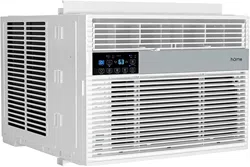Loading ...
Loading ...
Loading ...

11
Important Safety Instructions
9) Checks to electrical devices
Repair and maintenance to electrical components shall include initial safety checks and
component inspection procedures. If a fault exists that could compromise safety, then no
electrical supply shall be connected to the circuit until it is satisfactorily dealt with. If the
fault cannot be corrected immediately, but it is necessary to continue operation, an adequate
temporary solution shall be used. This shall be reported to the owner of the equipment, so all
parties are advised.
Initial safety checks shall include:
Ensuring that capacitors are discharged: this shall be done in a safe manner to avoid possible
sparking;
Ensuring that no live electrical components and wiring are exposed while charging, recovering, or
purging the system;
Ensuring that there is continuity of earth bonding;
7. Repairs to Sealed Components
1) During repairs to sealed components, all electrical supplies shall be disconnected from the unit
being worked on prior to the removal of sealed covers and other parts (if any). If it is necessary
to have an electrical supply connected to the unit during servicing, then a permanently operating
form of leak detection shall be located at the most critical point to warn of a potentially
hazardous situation.
2) Particular attention shall be paid to the following to ensure that when working on electrical
components, the casing is not altered in such a way that the level of protection is affected. This
shall include damage to the cables, an excessive number of connections, terminals not made to
the original specification, damage to seals, incorrect fitting of glands, etc.
Ensure that the unit is mounted securely.
Ensure that the seals or sealing materials have not been degraded to a point that they no longer
serve the purpose of preventing the ingress of flammable atmospheres. Replacement parts shall
be in accordance with the manufacturer's specifications.
NOTE: The use of silicon sealant may inhibit the effectiveness of some types of leak detection
equipment. Intrinsically safe components do not have to be isolated prior to working on them.
8. Repair to Intrinsically Safe Components
Do not apply any permanent inductive or capacitive loads to the circuit without ensuring that this will
not exceed the permissible voltage and current for the unit in use. Intrinsically safe components are
the only types that can be worked on while live and in the presence of a flammable atmosphere. The
test apparatus shall be at the correct rating. Replace the components only with parts specified by the
manufacturer. Other parts may result in the ignition of refrigerant in the atmosphere from a leak.
9. Cabling
Check that the cabling will not be subject to wear, corrosion, excessive pressure, vibration, sharp edges,
or any other adverse environmental effects. The check shall also consider the effects of aging or continual
vibration from sources such as compressors or fans.
10. Detection of Flammable Refrigerants
Under no circumstances shall potential sources of ignition be used in searching for or detecting refrigerant
leaks. A halide torch (or any other detector using a naked flame) shall not be used.
11. Leak Detection Methods
The following leak detection methods are deemed acceptable for systems containing flammable
refrigerants. Electronic leak detectors shall be used to detect flammable refrigerants, but the sensitivity
may not be adequate, or may need re-calibration. (Detection equipment shall be calibrated in a
refrigerant-free area.) Ensure that the detector is not a potential source of ignition and is suitable for the
refrigerant used. Leak detection equipment shall be set at a percentage of the LFL of the refrigerant and
shall be calibrated to the refrigerant employed and the appropriate percentage of gas (25 % maximum)
is confirmed. Leak detection fluids are suitable for use with most refrigerants, but the use of detergents
containing chlorine shall be avoided as the chlorine may react with the refrigerant and corrode the copper
pipework. If a leak is suspected, all naked flames shall be removed / extinguished. If a refrigerant leak is
Loading ...
Loading ...
Loading ...
